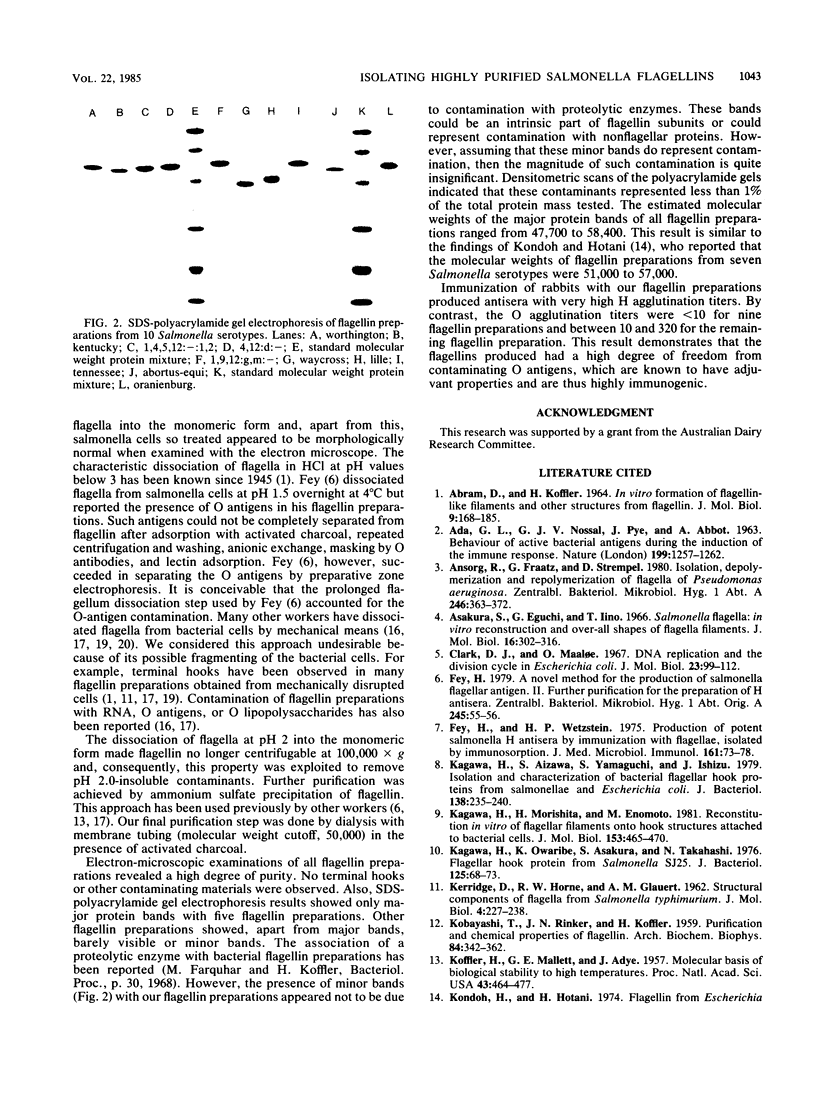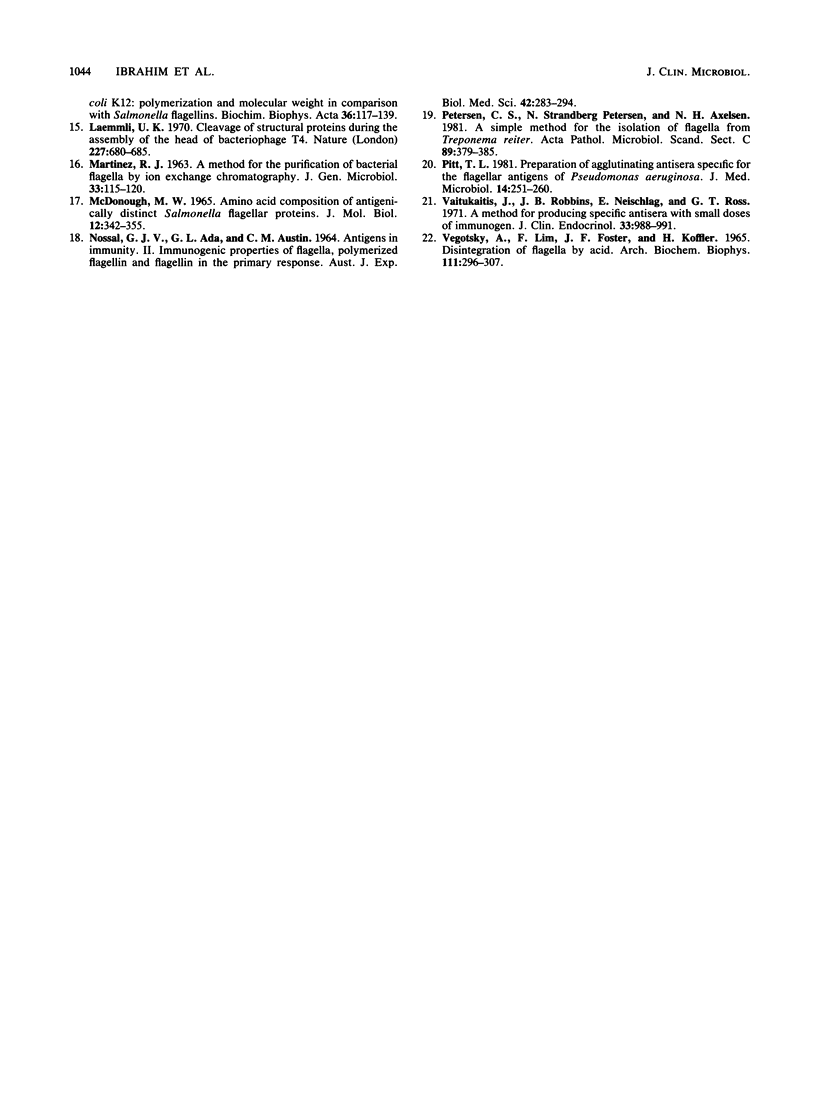Abstract
Ten different Salmonella serotypes were grown in a chemically defined medium supplemented with 0.01% yeast extract. After sedimentation of the cells by centrifugation, flagella were detached by exposure to pH 2 for 30 min at room temperature. The flagellaless cells were removed by centrifugation, and the flagellin in the supernatant was further purified by high-speed centrifugation, ammonium sulfate precipitation, and dialysis in 50,000-molecular-weight-cutoff tubing. The 10 flagellin preparations were of a high degree of purity, as demonstrated by electron microscopy, sodium dodecyl sulfate-polyacrylamide gel electrophoresis, and measurement of salmonella H and O agglutination titers of antisera raised in rabbits with the flagellin preparations as immunogens.
Full text
PDF




Images in this article
Selected References
These references are in PubMed. This may not be the complete list of references from this article.
- ABRAM D., KOFFLER H. IN VITRO FORMATION OF FLAGELLA-LIKE FILAMENTS AND OTHER STRUCTURES FROM FLAGELLIN. J Mol Biol. 1964 Jul;9:168–185. doi: 10.1016/s0022-2836(64)80098-x. [DOI] [PubMed] [Google Scholar]
- ADA G. L., NOSSAL G. J., PYE J., ABBOT A. BEHAVIOUR OF ACTIVE BACTERIAL ANTIGENS DURING THE INDUCTION OF THE IMMUNE RESPONSE. I. PROPERTIES OF FLAGELLAR ANTIGENS FROM SALMONELLA. Nature. 1963 Sep 28;199:1257–1259. doi: 10.1038/1991257a0. [DOI] [PubMed] [Google Scholar]
- Ansorg R., Fraatz G., Strempel D. Isolierung, Depolymerisierung und Repolymerisierung der Geisseln von Pseudomonas aeruginosa. Zentralbl Bakteriol A. 1980 Mar;246(3):363–372. [PubMed] [Google Scholar]
- Asakura S., Eguchi G., Iino T. Salmonella flagella: in vitro reconstruction and over-all shapes of flagellar filaments. J Mol Biol. 1966 Apr;16(2):302–316. doi: 10.1016/s0022-2836(66)80174-2. [DOI] [PubMed] [Google Scholar]
- Fey H., Wetzstein H. P. Production of potent salmonella H antisera by immunization with flagellae, isolated by immunosorption. Med Microbiol Immunol. 1975;161(1):73–78. doi: 10.1007/BF02120772. [DOI] [PubMed] [Google Scholar]
- KERRIDGE D., HORNE R. W., GLAUERT A. M. Structural components of flagella from Salmonella typhimurium. J Mol Biol. 1962 Apr;4:227–238. doi: 10.1016/s0022-2836(62)80001-1. [DOI] [PubMed] [Google Scholar]
- KOBAYASHI T., RINKER J. N., KOFFLER H. Purification and and chemical properties of flagellin. Arch Biochem Biophys. 1959 Oct;84:342–362. doi: 10.1016/0003-9861(59)90598-3. [DOI] [PubMed] [Google Scholar]
- Kagawa H., Aizawa S. I., Yamaguchi S., Ishizu J. I. Isolation and characterization of bacterial flagellar hook proteins from salmonellae and Escherichia coli. J Bacteriol. 1979 Apr;138(1):235–240. doi: 10.1128/jb.138.1.235-240.1979. [DOI] [PMC free article] [PubMed] [Google Scholar]
- Kagawa H., Morishita H., Enomoto M. Reconstitution in vitro of flagellar filaments onto hook structures attached to bacterial cells. J Mol Biol. 1981 Dec 5;153(2):465–470. doi: 10.1016/0022-2836(81)90291-6. [DOI] [PubMed] [Google Scholar]
- Kagawa H., Owaribe K., Asakura S., Takahashi N. Flagellar hook protein from Salmonella SJ25. J Bacteriol. 1976 Jan;125(1):68–73. doi: 10.1128/jb.125.1.68-73.1976. [DOI] [PMC free article] [PubMed] [Google Scholar]
- Koffler H., Mallett G. E., Adye J. MOLECULAR BASIS OF BIOLOGICAL STABILITY TO HIGH TEMPERATURES. Proc Natl Acad Sci U S A. 1957 Jun 15;43(6):464–477. doi: 10.1073/pnas.43.6.464. [DOI] [PMC free article] [PubMed] [Google Scholar]
- Laemmli U. K. Cleavage of structural proteins during the assembly of the head of bacteriophage T4. Nature. 1970 Aug 15;227(5259):680–685. doi: 10.1038/227680a0. [DOI] [PubMed] [Google Scholar]
- MARTINEZ R. J. A METHOD FOR THE PURIFICATION OF BACTERIAL FLAGELLA BY ION EXCHANGE CHROMATOGRAPHY. J Gen Microbiol. 1963 Oct;33:115–120. doi: 10.1099/00221287-33-1-115. [DOI] [PubMed] [Google Scholar]
- MCDONOUGH M. W. AMINO ACID COMPOSITION OF ANTIGENICALLY DISTINCT SALMONELLA FLAGELLAR PROTEINS. J Mol Biol. 1965 Jun;12:342–355. doi: 10.1016/s0022-2836(65)80258-3. [DOI] [PubMed] [Google Scholar]
- NOSSAL G. J., ADA G. L., AUSTIN C. M. ANTIGENS IN IMMUNITY. II. IMMUNOGENIC PROPERTIES OF FLAGELLA, POLYMERIZED FLAGELLIN AND FLAGELLIN IN THE PRIMARY RESPONSE. Aust J Exp Biol Med Sci. 1964 Jun;42:283–294. [PubMed] [Google Scholar]
- Petersen C. S., Pedersen N. S., Axelsen N. H. A simple method for the isolation of flagella from Treponema Reiter. Acta Pathol Microbiol Scand C. 1981 Dec;89(6):379–385. doi: 10.1111/j.1699-0463.1981.tb02716.x. [DOI] [PubMed] [Google Scholar]
- Pitt T. L. Preparation of agglutinating antisera specific for the flagellar antigens of Pseudomonas aeruginosa. J Med Microbiol. 1981 Aug;14(3):251–260. doi: 10.1099/00222615-14-3-251. [DOI] [PubMed] [Google Scholar]
- Vaitukaitis J., Robbins J. B., Nieschlag E., Ross G. T. A method for producing specific antisera with small doses of immunogen. J Clin Endocrinol Metab. 1971 Dec;33(6):988–991. doi: 10.1210/jcem-33-6-988. [DOI] [PubMed] [Google Scholar]
- Vegotsky A., Lim F., Foster J. F., Koffler H. Disintegration of flagella by acid. Arch Biochem Biophys. 1965 Aug;111(2):296–307. doi: 10.1016/0003-9861(65)90190-6. [DOI] [PubMed] [Google Scholar]




